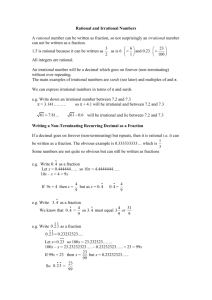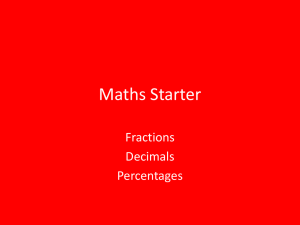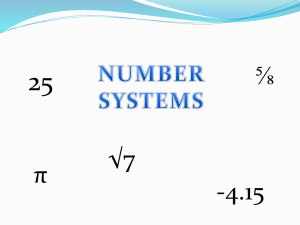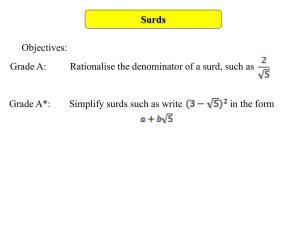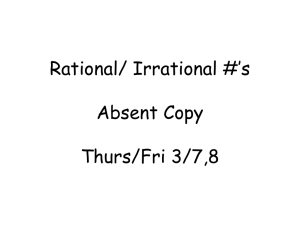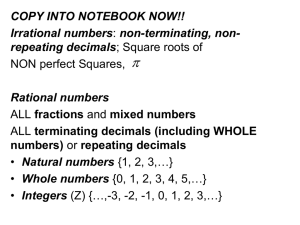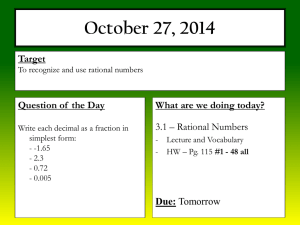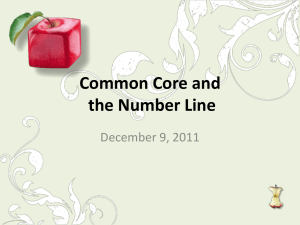x) Rational and Irrational numbers - Student - school
advertisement
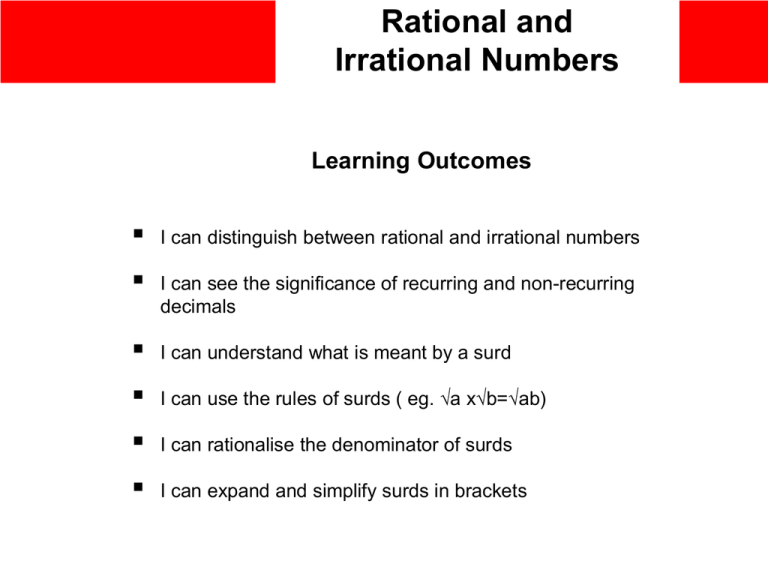
Rational and Irrational Numbers Learning Outcomes I can distinguish between rational and irrational numbers I can see the significance of recurring and non-recurring decimals I can understand what is meant by a surd I can use the rules of surds ( eg. √a x√b=√ab) I can rationalise the denominator of surds I can expand and simplify surds in brackets Rational Numbers A rational number is a number that can be written as a ratio. That means it can be written as a fraction, in which both the numerator (the number on top) and the denominator (the number on the bottom) are whole numbers. 8 is a rational number because it can be written as the fraction 8/1. 3/4 is a rational number because it can be written as a fraction. 0.125 is a rational number because 0.125 = 125/100 = 1/8 i.e. can be written as a fraction 1.75 is a rational number because 1.75 = 7/4 i.e. can be written as a fraction Irrational Numbers All numbers that are not rational are considered irrational. An irrational number can be written as a decimal, but not as a fraction. An irrational number has endless non-repeating digits to the right of the decimal point. Here are some irrational numbers: π = 3.141592… √2 = 1.414213… Rational and Irrational Numbers 1. Which one of these equations has solutions which are irrational? A 3x2 = 4 B 3x2 = 4/3 C 3x2 = 3/4 2. Decide whether each of the numbers in the table is rational or irrational; and put a tick in the appropriate box. number Rational Irrational √7 3√8 3 1. 27 5 .1 10 5 10. 10 22 7 0.8 1 π Rational and Irrational Numbers D = b2 – 4ac D is evaluated in each of the following cases: i. b = 3, a = 1, c = 1.25 ii. b = 10π, a = 8π, c = 2π iii. b = 12, a = 4, c = 9 iv. b = -6, a = -1, c = -4 3. Which two of these values of D are irrational? Rational and Irrational Numbers 4. Which two of the numbers a, b, c in the answers below are rational? 5cm O Area of circle = a cm2 8 cm W Z X Y 6 cm Length of EF = b cm Length of WY, the diagonal of rectangle WXYZ = c cm Rational and Irrational Numbers 5. Which two of the following are rational? i. √5 v. √5-2 ii. 4π vi. √41/4 iii. vii. √(22+23) 3√100 iv. √0.4 viii. √(32+33) Recurring Decimals A recurring decimal is a decimal fraction which repeats itself forever. . 1/3 gives the recurring decimal fraction 0.333333... = 0.3 . . 1/7 gives the recurring decimal fraction 0.142857142857142857... = 0.142857 The recurring pattern is usually indicated by placing a dot over the first digit of the recurring pattern, and another dot over the final digit of the recurring pattern. Also known as periodic decimal. The period of a recurring decimal is the number of digits which forms the repeating pattern. Recurring Decimals Example Express 0.12 as a fraction. .. ① 0.12 = 0.12121212… Let x = 0.1212121212… ② We want to move the decimal point to the right, so that the first "block" of repeated digits appears before the decimal point. Remember that multiplying by 10 moves the decimal point 1 position to the right. x = 0.1212121212… 100 x = 12.1212121212… ③ Now we can subtract our original number, x, from both sides to get rid of everything after the decimal point on the right: 100 x = 12.1212121212… x = 0.1212121212… 99 x = 12 x = 12 99 Recurring Decimals 1. When written in decimal form, which two of the following are recurring decimals. i. √6 iv. 1/4π ii. √4/49 v. 3√12 iii. √1.5 vi. 4/17 Recurring Decimals 2. Express as a fraction: . . i. 0.688 . ii. 1.3 . . iii. 0.52123 Surds Surds are numbers left in 'square root form' (or 'cube root form' etc). They are therefore irrational numbers. The reason we leave them as surds is because in decimal form they would go on forever and so this is a very awkward way of writing them. Addition and Subtraction of Surds When adding and subtracting surds we need the numbers being square rooted (or cube rooted etc) to be the same. Examples: 5√7 - 2√ 7 = 3√ 7 √12 + √75 = √3√4 + √3√25 = 2√3 + 5√3 = 7√3 Surds Multiplication and Division √a √b = √ab √a x √a = a √a = √b a b Examples: √3 x √12 = √36 = 6 √12 = √6 12 = √2 6 (1 + √3)(2 + √3) = 2 + √ 3 + 2 √3 + √3 √3 = 2 + 3 √3 +3 = 5 + 3 √4 Surds Simplify the following: 1. √ 20 = 2. √4 + √4 = 3. √5 x √12 = 4. √16 = √2 5. (1 + √3)(2 + √3) = 6. (√18 - √2)2 = Rationalising the Denominator It is untidy to have a fraction which has a surd denominator. This can be 'tidied up' by multiplying the top and bottom of the fraction by a particular expression. This is known as rationalising the denominator. Example: 1 √2 1+2 1 - √2 1 x √2 √2 √2 = = = (1 + 2)(1 + √2) (1 - √2)(1 + √2) √2 √2 x √2 = = √2 2 1 + √2 + 2 + 2√2 1 + √2 - √2 - 2 = 3 + 3√2 -1 Rationalising the Denominator Rationalise the following: (i) 8 √2 = (ii) 12 √3 = (iii) (iv) 2 . = 3 + √2 = 1+ √3 1 - √3 Additional Notes Rational and Irrational Numbers Learning Outcomes: At the end of the topic I will be able to I can distinguish between rational and irrational numbers I can see the significance of recurring and non-recurring decimals I can understand what is meant by a surd I can use the rules of surds ( eg. √a x√b=√ab) I can rationalise the denominator of surds I can expand and simplify surds in brackets Can Do Revise Further

